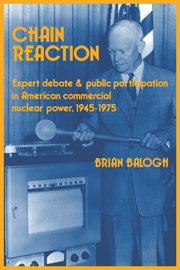 Chain Reaction
Chain Reaction Book contents
- Frontmatter
- Contents
- Acknowledgments
- List of abbreviations
- 1 From fission to fusion: professionalization and politics in twentieth-century America
- 2 The promise of the proministrative state: nuclear experts and national politics, 1945–1947
- 3 Forging an iron triangle: the politics of verisimilitude
- 4 Triangulating demand: the Atomic Energy Commission's first decade of commercialization
- 5 The centrifugal push of expertise: reactor safety, 1947–1960
- 6 The magnetic pull of professional disciplines, issue networks, and local government
- 7 Nuclear experts on top, not on tap: mainstreaming expertise, 1957–1970
- 8 Nuclear experts everywhere: the challenge to nuclear power, 1960–1975
- 9 Conclusion: harnessing political chain reactions
- Index
4 - Triangulating demand: the Atomic Energy Commission's first decade of commercialization
Published online by Cambridge University Press: 07 May 2010
- Frontmatter
- Contents
- Acknowledgments
- List of abbreviations
- 1 From fission to fusion: professionalization and politics in twentieth-century America
- 2 The promise of the proministrative state: nuclear experts and national politics, 1945–1947
- 3 Forging an iron triangle: the politics of verisimilitude
- 4 Triangulating demand: the Atomic Energy Commission's first decade of commercialization
- 5 The centrifugal push of expertise: reactor safety, 1947–1960
- 6 The magnetic pull of professional disciplines, issue networks, and local government
- 7 Nuclear experts on top, not on tap: mainstreaming expertise, 1957–1970
- 8 Nuclear experts everywhere: the challenge to nuclear power, 1960–1975
- 9 Conclusion: harnessing political chain reactions
- Index
Summary
The Atomic Energy Commission, the Joint Committee on Atomic Energy, and the nascent nuclear industry embraced military demand as the primary stimulus to reactor development in the late forties and early fifties. This dwarfed demand for civilian applications. Alvin Weinberg, research director of Oak Ridge National Laboratory and a pioneer of power reactors, was one of the first observers to acknowledge this dichotomy in demand. “There was a much deeper reason for the post-war lull in reactor development” than the postwar scientific demobilization commonly cited, Weinberg told a University of Virginia audience in 1950. “[W]hen the time came to ask for the many millions needed to build reactors, there were few who rose vigorously to say the country needs nuclear power reactors – reactors which are expensive, perhaps dangerous, certainly far more complicated than coal – and needs them badly enough to pay the millions required to finance them.”
The military was the exception to this rule. “[I]t was precisely the demands of the military which have put vigor and push into the terribly difficult and expensive job of extracting useful power from uranium fission,” Weinberg continued. “The disadvantages of nuclear power – the radioactivity, the expense, the fuel reprocessing which make private power companies remarkably disinterested for the time being are for certain military purposes outweighed by the advantages – compactness and independence of oxygen supply.” Weinberg cited the nuclear-powered submarine and airplane as prime examples of how military demand had advanced power reactor technology.
- Type
- Chapter
- Information
- Chain ReactionExpert Debate and Public Participation in American Commercial Nuclear Power 1945–1975, pp. 95 - 119Publisher: Cambridge University PressPrint publication year: 1991


